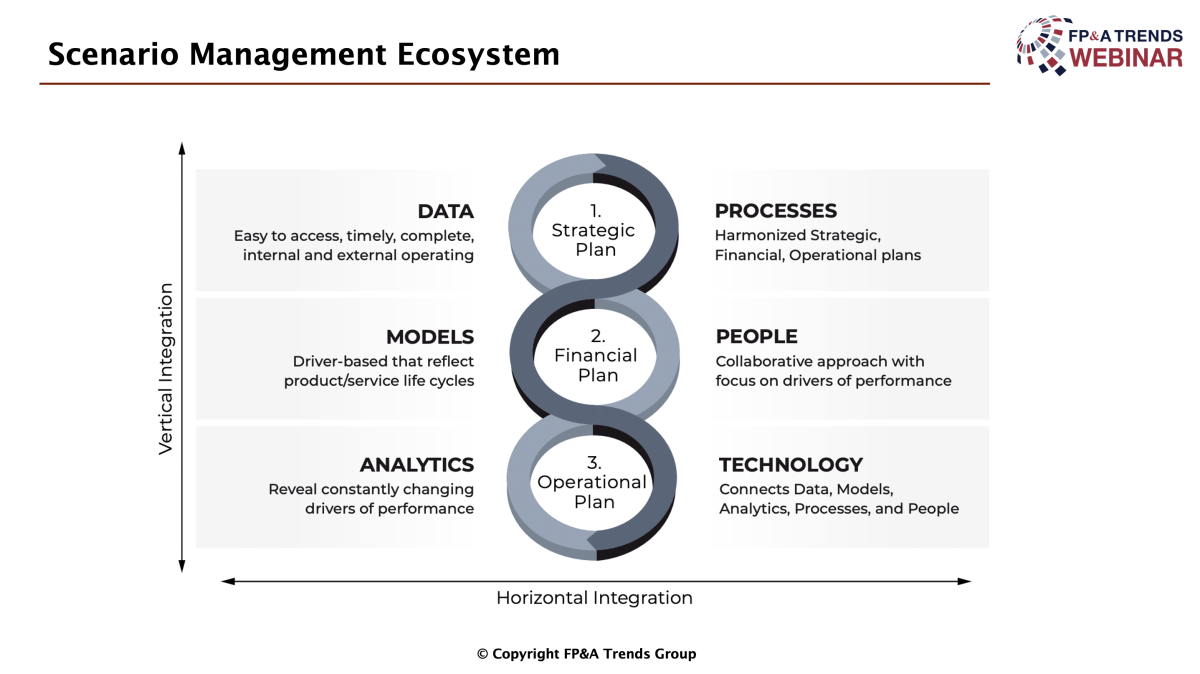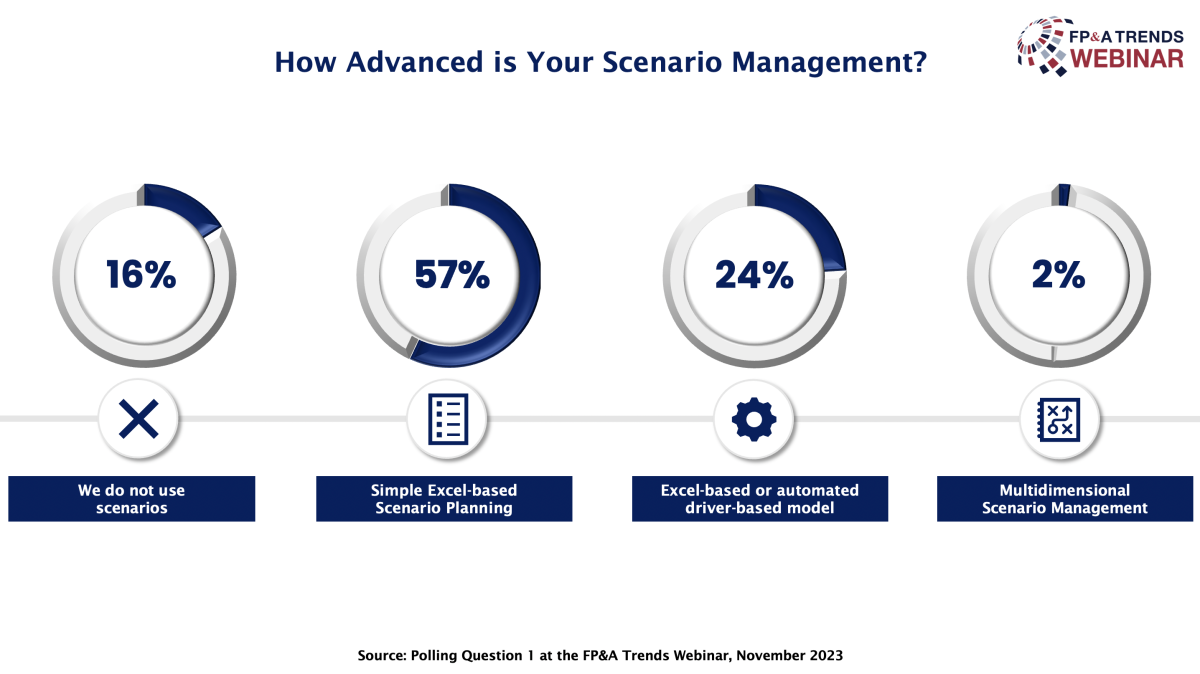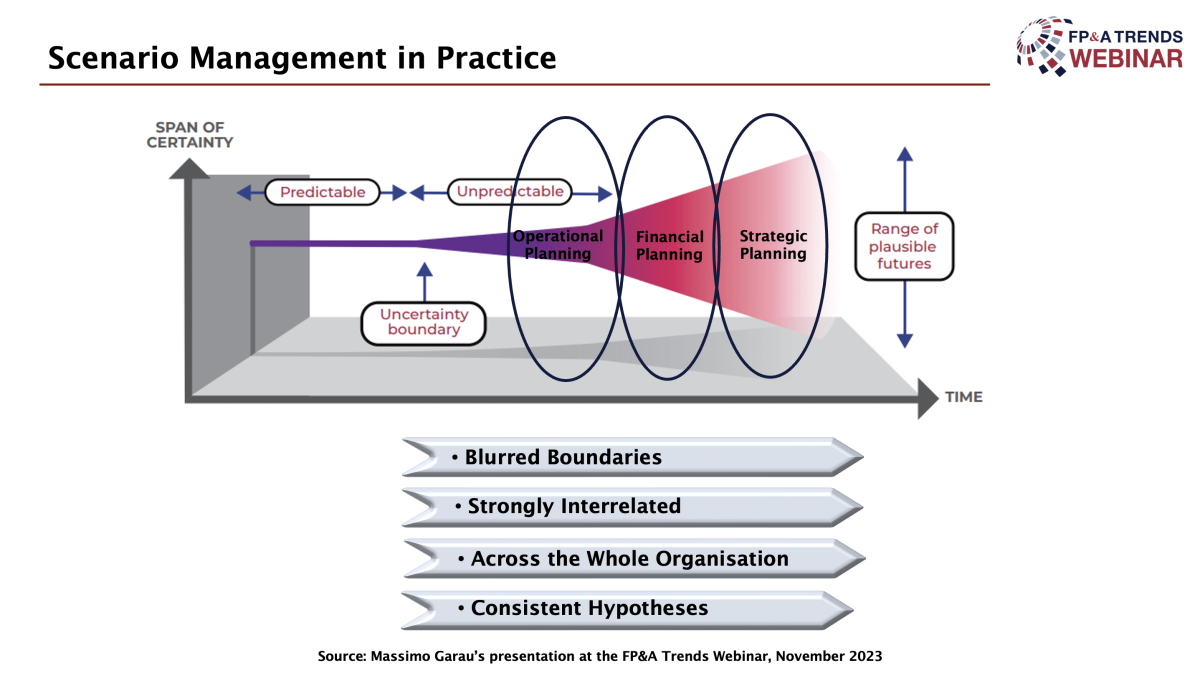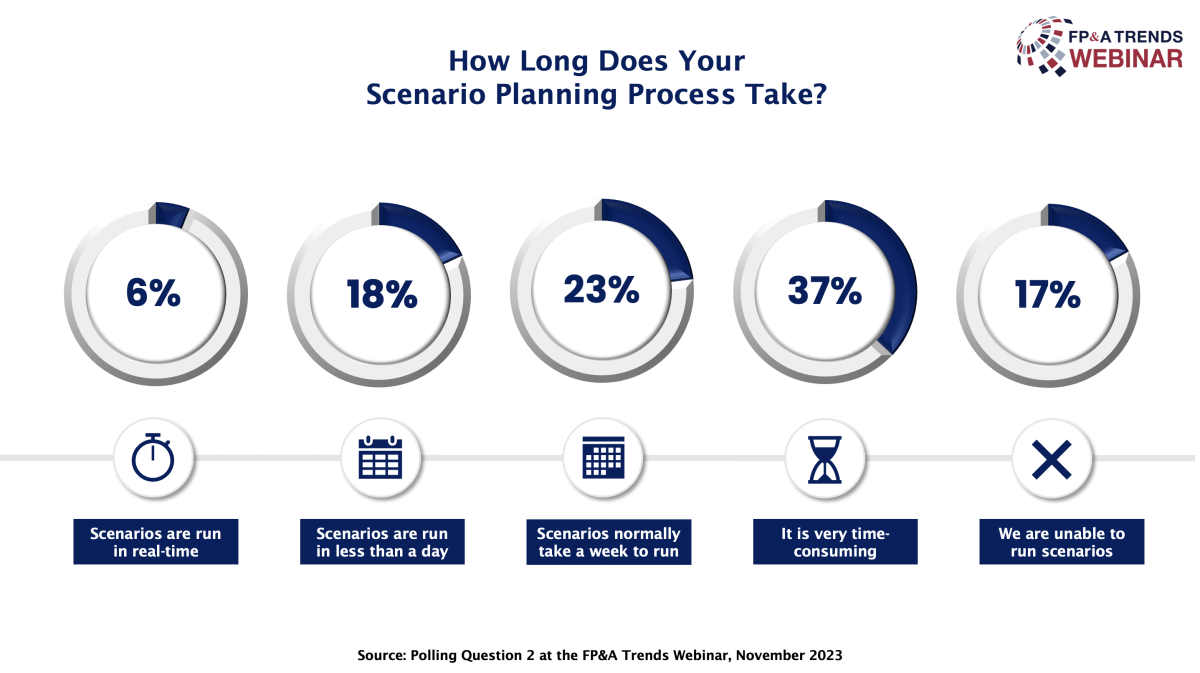I attended a global FP&A Trends webinar focused on the potential of FP&A Scenario Management. Nearly 400 people from different parts of the world joined this session, featuring three presentations by Cornelia Nitra, FD Germany, Denmark and Finland at Coca-Cola, Massimo Garau, CFO at Veganz Group AG, and Dr Rolf Gegenmantel, CPO at Jedox, and led by Hans Gobin, International FP&A Board Ambassador.

Hans Gobin started the presentation and explained the key elements of the Scenario Management ecosystem. There are six key Scenario Management enablers, which should be integrated horizontally and vertically as per the figure below:

Figure 1
Critical Scenario Management Factors from Coca-Cola
Cornelia Nitra began her presentation by explaining the impact of uncertainty on businesses across the world. The pandemic was the key starting point for Scenario Management deployment at Coca-Cola.
Coca-Cola’s Dynamic Strategy to Adapt to Changing Consumer and Shopper Behaviour
1. Define key variables with impact on the current business plan
Their first step in establishing such a strategy was to carve out the following:
- key variables impacting the business plan,
- what factors could create the biggest variability impacting financials, including the most valuable data points and drivers to use,
- the indicators which should have predictive power for progressing towards the future.
2. Create thresholds and trigger points
It’s not just important to look at scenarios but also at action plans regarding your next actions in case you meet those points. Cornelia further explained this using an example of Coca-Cola. They started looking at macroeconomic indicators, such as personal consumption expenses, Consumer Price Index or Consumer Confidence, and then, further analysed what was impacting the top line and identified the performance trends to capture potential opportunities.
3. Operationalise dynamic planning
To integrate dynamic planning and Scenario Management into strategic, financial and operational processes, they created a dashboard with a cross-light system, incorporating key routines and performance-trigger tracking.
What Are the Critical Factors in Scenario Management Ecosystem?
The top three elements are as follows:
1. Data. It’s important to have clarity and consistency in all available data sources to be able to identify leading indicators and integrate Machine Learning.
2. Embedded in business and finance processes. Scenario Management should be embedded in key finance routines, along with action plans after every review.
3. Business Partnering in the network. Constant communication on the potential scenarios and outcomes can help cross-functional teams identify the action plans.
How Advanced Is Your Scenario Management?
We then transitioned to the first poll. The poll results showed that 57% of the webinar attendees use Excel-based Scenario Planning, while 24% have Excel-based or automated driver-based models. However, 16% do not use scenarios at all, and only 2% have a multi-dimensional Scenario Management.

Figure 2
What Are the Key Distinctions between Scenario Planning and Scenario Management?
Scenario Planning is about looking from the top into the distant future, while Scenario Management faces the real scenarios as they come through. The quality of planning influences the quality of Scenario Management.
How to Embed Scenario Management in Practice?
Massimo Garau began his presentation by explaining the relationship between uncertainty and time. As we move into the future, the uncertainty increases, so the planning becomes exponentially more challenging and increasingly important.
What Are the Different Kinds of Planning?
Strategic Planning: It compounds a span of 5+ years, so it is highly unpredictable, and this plan will not be too detailed. The examples of scenarios for Strategic Planning may typically include some technology breakthroughs and policy changes.
Financial Planning: This is a blend of future and present actions, so the uncertainty is lower as we are planning for a shorter time period. We factor in a detailed view of financial statements, including Profit and Loss, Balance Sheet and Cash Flow at a cost-centre level monthly. The finance department owns this plan, as they use it as a steering and control instrument. The examples may include product launches, changes in competitor’s environments and changes in the customer landscape.
Operational Planning: This is about the present or immediate actions and decisions for a short span of time. For example, less than a year. The uncertainty is low, so here, we often see binary scenarios with “yes”/“no”, and the line management owns it. The examples include short-term capacity planning and trade activities.
The picture below shows that the boundaries between the three stages are blurred, and it is not always easy to distinguish them, so the constant consequent assumptions should be interrelated.

Figure 3
How Long Does Your Scenario Planning Process Take?
The second polling results showed that 37% of the audience could run scenarios, though they are very time-consuming for them. 23% said that scenarios normally take a week to run, while 18% said scenarios are run in less than one day. Unfortunately, 17% are unable to run scenarios at all, whereas only 6% can run scenarios in real-time.

Figure 4
What Is the Role of Modern Technology in Scenario Planning?
Dr Rolf Gegenmantel began his presentation by explaining planning challenges and their impact on planning systems.
As per the diagram below, we need to be flexible to adapt to a changing environment and to reflect the complexity of certain things in the systems. Automation and digitalisation can eliminate time wasters, while integration of cloud and SaaS can foster data scalability.
Collaboration and Business Partnering can help us identify correlations between departments and balance conflicting goals.

Figure 5
How to Build an Adaptable Planning and Performance Management Platform?
The data foundation should be able to integrate all the relevant information, and data from different systems and departments to put it into a model where we can represent the driver-based logic with an AI system capability.
Process automation and leveraging Scenario Management to provide data through dashboards, offering users the right information in the right format, lays the foundation for managing organisational scenarios effectively.
We must embrace a mindset ready for this journey: leaving traditional ways behind to work cross-functionally, share information and challenge each other.
Key Takeaways
It is important to start the journey with the key drivers that may have the most material potential variance. Scenario Management is considered a continuous learning journey, which requires step by step improvements.
Organisations should be ready to plan for the unimaginable, which may affect the future. The webinar emphasised the necessity of being bold about what you want to achieve. However, starting small remains crucial.
To watch the webinar recording, please click here.
This webinar was proudly sponsored by Jedox.
Subscribe to
FP&A Trends Digest

We will regularly update you on the latest trends and developments in FP&A. Take the opportunity to have articles written by finance thought leaders delivered directly to your inbox; watch compelling webinars; connect with like-minded professionals; and become a part of our global community.
